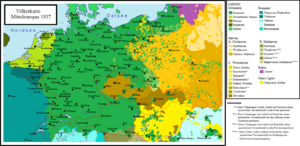Sudetenland facts for kids

The Sudetenland was a historical name for certain parts of what used to be Czechoslovakia. These areas were in the north, south, and west of the country. Many people who spoke German lived there. These German speakers had lived in the border areas of Bohemia, Moravia, and Czech Silesia since the time of the Austrian Empire.
The name "Sudetenland" became well-known after World War I. Before that, it wasn't commonly used. After World War I, the large country of Austria-Hungary broke apart. The German-speaking people in these areas then found themselves living in the new country of Czechoslovakia.
In 1938, there was a big problem called the Sudeten crisis. Nazi Germany, led by Adolf Hitler, wanted to take over the Sudetenland. They believed all German-speaking people should be part of Germany. This led to the Munich Agreement, where other countries allowed Germany to take the Sudetenland. Part of the borderland was also taken by Poland. After this, the Sudetenland became a special area ruled by Germany.
After World War II, Czechoslovakia became a country again. The German-speaking people who lived in the Sudetenland were asked to leave. Today, almost everyone living in this region speaks Czech.
The word Sudetenland comes from German. Land means "country." Sudeten comes from the name of the Sudeten Mountains. These mountains are along the northern border of the Czech Republic and Lower Silesia (which is now in Poland). However, the Sudetenland included areas much larger than just these mountains.
Today, parts of the Czech regions of Karlovy Vary, Liberec, Olomouc, Moravia-Silesia, and Ústí nad Labem are within the area that was once called Sudetenland.
Contents
History of the Sudetenland
German Speakers in the Region
For a long time, many German-speaking people lived in the areas that became the Sudetenland. They had been there since the time of the Austrian Empire. These areas were important for trade and industry.
After World War I
After World War I ended in 1918, the Austro-Hungarian Empire was broken up. New countries were formed. Czechoslovakia was one of these new countries. Many German-speaking people who lived in Bohemia, Moravia, and Czech Silesia suddenly became citizens of Czechoslovakia. They were called Sudeten Germans.
Some Sudeten Germans felt they were not treated fairly in the new country. They wanted to be part of Germany or Austria. This feeling grew stronger over time.
The Sudeten Crisis of 1938
In the 1930s, Nazi Germany became very powerful. Its leader, Adolf Hitler, wanted to unite all German-speaking people under German rule. He started demanding that the Sudetenland be given to Germany. This caused a big international problem known as the Sudeten Crisis.
Other European countries, like Britain and France, wanted to avoid another war. In September 1938, they met with Germany and Italy in Munich. This meeting led to the Munich Agreement. In this agreement, they allowed Germany to take the Sudetenland from Czechoslovakia.
German Rule and World War II
After the Munich Agreement, German troops marched into the Sudetenland. The region became part of Germany. Many Czech people living there were forced to leave. The Sudetenland was then used by Germany during World War II.
After World War II
When World War II ended in 1945, Germany was defeated. Czechoslovakia became an independent country again. The leaders of Czechoslovakia decided that the German-speaking people in the Sudetenland should leave. This was because many of them had supported Germany during the war.
Between 1945 and 1948, most of the Sudeten Germans were expelled from Czechoslovakia. They had to move to Germany or Austria. This was a very difficult time for many families. Today, the Sudetenland is fully part of the Czech Republic, and most people there speak Czech.
Images for kids
-
Ethnic distribution in Austria-Hungary in 1911: areas with a German majority are shown in pink, those with Czech majorities in blue.
-
Konrad Henlein speaking in Carlsbad, 1937. He was a leader of the Sudeten Germans.
-
A vandalized synagogue in Teplice, the morning after Kristallnacht in 1938.
See also
 In Spanish: Sudetenland para niños
In Spanish: Sudetenland para niños










